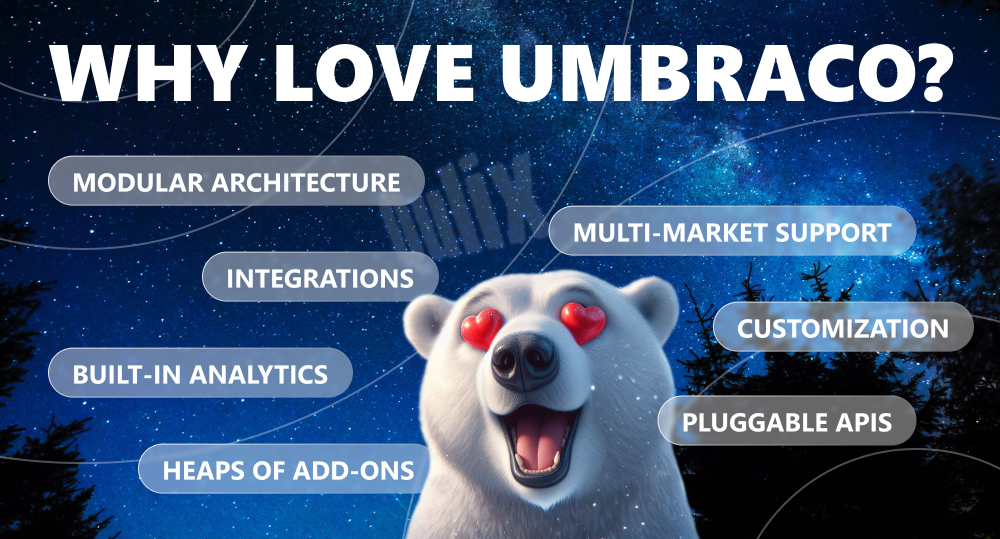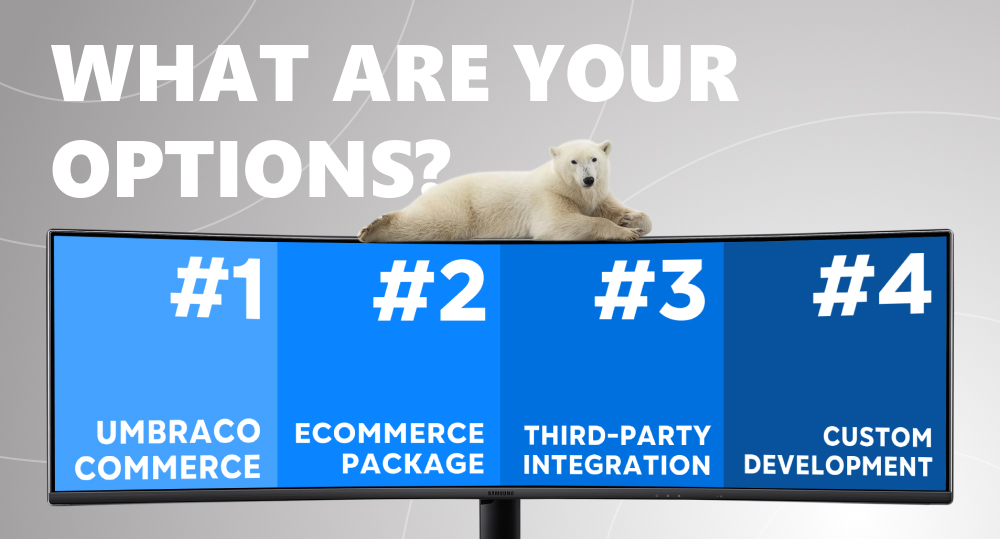When the words “Umbraco eCommerce website” dance in your mind, you might envision a relic from the digital Stone Age — clunky, outdated, and collecting virtual cobwebs. Reserve your judgement. You’d be surprised. Umbraco isn’t just another contender; it’s a heavyweight champion, outshining even Shopify and WooCommerce.
How so? Buckle up! In this guide, we’ll reveal the secret sauce to crafting dazzling online stores. Embrace Umbraco, an SEO-friendly CMS with a minimum of code and a maximum of customization.
written by:
Kristina Prokopovich
Project Coordinator
Contents
eCommerce with Umbraco: Swipe Right or Left?
WordPress, WooCommerce, Shopify, Magento, Wix, BigCommerce… And that Umbraco! It's mind-boggling to identify the number of CMSs out there. Would you agree the world is looking for a crisp breeze sweeping through the online sales industry? That's exactly what Umbraco brings to the table. As good as it feels, opinions on this CMS are divided, with some companies absolutely loving its features, while others raising an eyebrow. Let's dissect the pros and cons to see if Umbraco is your perfect match.
Reasons to Swipe Right
#1. The Official eCommerce Package
You may have heard of Umbraco Cloud, Heartcore, and Forms. But did you know that this content management system has its own solution for virtual shopping journeys — Umbraco Commerce? It has all the major and minor components honed to run a thriving online marketplace:
- Modular architecture with flexible customization options;
- Slick product, inventory, and order management;
- A broad range of pluggable APIs;
- Integration of core commercial tools: payment services, shipping providers, marketing automation systems;
- Built-in dashboards and analytics;
- Multi-market support: multiple currencies, languages, tax rates, and stores;
- User-oriented discount rules;
- Rewards builder.
#2. Security
Security is paramount in the eCommerce industry, and Umbraco takes it seriously. Consider this: according to Statista, in 2022, global eCommerce losses from virtual payment fraud reached a staggering $41B. In 2023, that number was projected to rise to $48B. Umbraco's robust protection measures will dispel your anxiety at the sight of these figures. With frequent security updates, HTTPS support, and an eager user base that prioritizes vulnerability remediation, you can have peace of mind knowing your online store is in expert hands.
#3. Community Power
While Java has JUGs and Python has Pythonistas, Umbraco rallies an equally devoted fan base. The official website declares over 220,000 active community members, each nurturing Umbraco's growth. Therefore, if you have an idea for something you'd like to create within Umbraco, chances are someone has already trodden that path and stands ready to lend a helping hand.
Reasons to Swipe Left
#1. Market Share
When sizing up Umbraco against more mainstream platforms like Magento or WooCommerce, its market share may appear modest. Fewer users translate to fewer off-the-shelf e-commerce plugins. But here’s the twist: less is more. Umbraco's leaner user base means it's less vulnerable to cyberattacks, giving it the advantage of a more secure online shopping environment. Plus, Umbraco sidesteps feature bloat, ensuring relevance for e-store owners.
#2. Ticklish Setup
While Umbraco offers a heap sight of customizing options, setting up a digital marketplace with it may demand technical prowess. This can be a challenge for businesses without in-house IT resources or those looking for a simpler solution. Fortunately, you always have the option to contact a dedicated software agency and outsource Umbraco eCommerce services.
Umbraco: Brief Summary
Category
What about Umbraco?
Type
Open-source CMS
Technology
.NET framework, using ASP.NET Core and C#
Founder
Niels Hartvig
First Release
2003
Active Installs
730K+
Initial Price
$0
Prominent Clients
Volvo, Mercedes-Benz, Carlsberg, Council of the EU, Shawbrook Bank, Domino’s Pizza
Active Community Members
220K+
Number of Free Packages
1200+
If you’re curious to explore Umbraco further, check out our latest piece of writing, “What Is Umbraco?”.
Setting Up Umbraco eCommerce Solutions
If you've decided to swipe right and choose Umbraco to create your e-store, let's find out how to get started.
Umbraco lives up to its reputation as a fully customizable CMS and offers a ton of valuable resources: packages, extensions, and integrations. Here are the core Umbraco eCommerce options:
Option #1. Umbraco Commerce
Perfect for:
- Enterprises navigating diverse markets and regions and striving for a comprehensive solution that can be easily managed and scaled under heavy traffic.
Umbraco Commerce is a robust platform that allows users to create and manage online stores, from product listings to inventory management and payment processing. It offers extensive configuration options to create a unique and personalized shopping experience for your customers. Let's see how it can help you build an eCommerce solution in a few simple steps.
1) Install Umbraco CMS;
2) Add the Umbraco Commerce package;
3) Configure your product catalog, shipping and taxation rules, adjust payment gateways;
4) Work with the design: choose from ready-made Umbraco eCommerce templates or craft your own unique look;
5) Add a new product to the catalog, upload images, set pricing and inventory levels;
6) Spice up your store: design showstopping product pages, implement search and filtering mechanisms, blend compelling content with your platform;
7) Secure your website: encrypt sensitive data, prevent unauthorized access, and comply with relevant data protection regulations;
8) Market your offer: handle SEO optimization, email marketing, and integrate social media.
Option #2. Umbraco eCommerce Package
Perfect for:
- Businesses seeking simplicity without extensive customization.
You don't have to rely solely on Umbraco Commerce when building a web store. Alternatively, you can opt for a pre-built Umbraco eCommerce plugin. These add-ons come with ready-made features and integrations, enabling you to quickly set up an e-commerce store within the platform. Here's their shortlist:
- Tea Commerce;
- Ucommerce;
- Vendr.
Option #3. Third-Party Integration
Perfect for:
- Users of other eCommerce-related platforms and tools.
If your business is already using a third-party e-trade platform, such as Magento or Shopify, you can easily integrate it with Umbraco. This option allows you to maintain your current infrastructure while tweaking your content with Umbraco's SEO features. Which trendy platforms you can integrate:
- Raptor;
- uMarketingSuite;
- Storm Commerce.
Option #4. Custom Development
Perfect for:
- Businesses with distinctive requirements and specific branding needs wishing to build a one-of-a-kind solution.
Custom development entails collaborating with a seasoned Umbraco development team to deliver a bespoke solution aligned with your business. This approach grants complete control over design, functionality, and seamless connection with other systems: CRMs, third-party APIs, or inventory management tools.
I’m In for Umbraco eCommerce, When Do We Start?
So, there you have it. Umbraco's perfect blend of content management and e-commerce features positions it as a go-to choice for launching your digital marketplace — a new eBay, if you will. No matter what you sell — tangible goods, services, cryptocurrencies, subscriptions, or even those coveted superhero action figures — Umbraco stands ready. You can customize your store to match your brand's essence, integrate it with various payment systems and shipping providers, and set up SEO techniques to boost your visibility in search engines.
But don't just take our word for it. Try it for yourself and discover your own reason to love Umbraco.
Disclaimer: Side effects may include increased profits, happy customers, and occasional victory dances.
If you need any help, just drop us a line. We’re always here to help you unleash your inner Umbraco e-commerce superhero. Remember: no capes are required. Unless you want to dazzle your audience. In that case, go for it.
FAQ
With heaps of options available, we understand how tricky it can be to choose a reliable platform. Here are our top 3, backed by Forbes, TechRadar, Zapier, and our own insights:
1) Umbraco:
- Less known in the e-commerce realm, but don't underestimate it;
- Shines with its customizability and user-centric interface;
- Seamlessly integrates with other systems;
- Allows managing content like a maestro.
2) Shopify:
- User-friendly, like a well-worn path;
- Offers an extensive app store;
- Ideal for small to medium-sized businesses.
3) WooCommerce:
- Built as a WordPress plugin;
- Flexibility personified;
- Perfect for existing WordPress users.
Sure! While you may have heard that Umbraco is primarily used as a powerful content management system, it also offers robust e-commerce features that make it a reliable and flexible platform for all kinds of virtual stores. Here's why it's a smart choice:
- Full control over the design and functionality of your store;
- Freedom to edit HTML, CSS, and JS code;
- Umbraco e-commerce tracking functionality;
- Vast content management capabilities to extend functionality and craft SEO-optimized content;
- Supportive network of developers and users.
Yes. Umbraco is just the right place for such an endeavor. The platform offers you the ability to generate product listings, manage stock levels, process payments, and track orders, among other essential e-commerce features.
Yes, Google Sites allows building e-stores. However, this practice has certain limitations. There's a better option for running marketplaces. It's a website builder, like Umbraco. Such platforms are primarily focused on creating websites of all kinds, including user-friendly e-commerce solutions.
Umbraco 7 is outdated and no longer supported by Umbraco HQ. It doesn't work with Umbraco Commerce, and you'll have to rely on third-party extensions or additional packages that may be incompatible or insecure. Therefore, if you want to launch a reputable online shop, choose Umbraco 10 and later versions.
- Avenue Clothing;
- Tom Tailor;
- Billund Airport.

Contacts
Feel free to get in touch with us! Use this contact form for an ASAP response.
Call us at +44 781 135 1374
E-mail us at request@qulix.com









